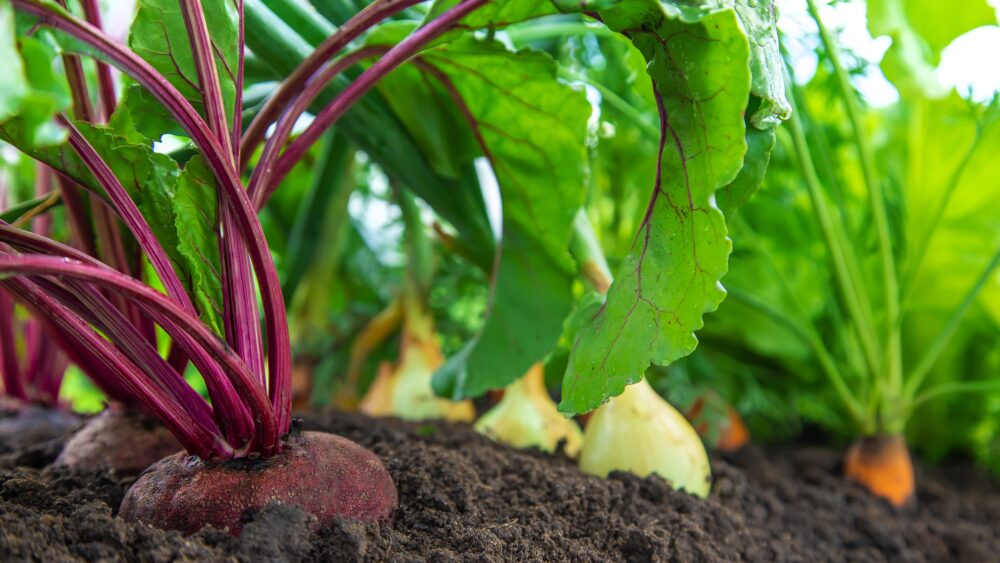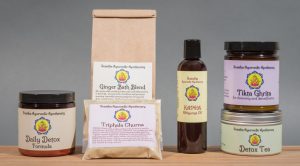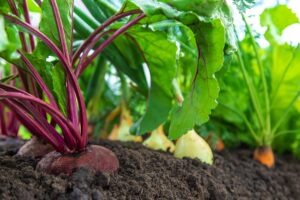 When it comes to eating an Ayurvedic diet, eating for the season is one of the most important food rules you can follow for your digestion (Agni) and your total health. Each season carries specific qualities (gunas), elements, and doshas. Since you are immersed in your environment, these pervasive qualities can easily become elevated in your own being, whether in physical, mental, or emotional manifestations.
When it comes to eating an Ayurvedic diet, eating for the season is one of the most important food rules you can follow for your digestion (Agni) and your total health. Each season carries specific qualities (gunas), elements, and doshas. Since you are immersed in your environment, these pervasive qualities can easily become elevated in your own being, whether in physical, mental, or emotional manifestations.
Why is seasonal eating important?
Seasonal eating allows you to be more in line with Mother Nature and use Her innate Wisdom to maintain balance throughout the year. According to Ayurveda, each season will be predominant in a specific dosha(s) and qualities (gunas), making it easy for them to increase in your body, mind, and consciousness. Generally speaking, seasonal eating will help to balance these heightened qualities by providing the opposite qualities through your food choices and dietary practices. By eating for the spring season, you can prevent common issues such as colds, hay fever, sinus infections, and seasonal allergies.
What are the qualities of spring?
Early to mid spring is considered the season of Kapha dosha and carries the qualities of being heavy, damp, and congested. Kapha dosha has been steadily building up and solidifying throughout the winter; as spring comes in, this Kapha slowly begins to “melt” away, clogging your bodily channels and creating congestion throughout your system. Springtime often brings more rainy, cloudy days, which increases Kapha further and creates more dampness in your body and mind.
Spring is known as one of the transitional seasons, as it is neither excessively hot nor cold and is typically mild by nature. Between spring’s moderate climate, the increase of Kapha dosha, and the heavy, damp qualities that are predominant, spring is generally one of the best times of the year for performing a cleanse.
How can I use this information in my day-to-day life?
As the spring season transitions in, you can keep your system strong and in balance by honoring and acknowledging the increase of Kapha dosha. To reduce the heavy, damp, and stuck qualities Kapha may bring, eating foods that are light, cleansing, and stimulating can often be very helpful. Following a Kapha-reducing diet may be beneficial, but if you are experiencing a Vata or Pitta imbalance, it may be best to follow a Vata-Kapha diet or a Pitta-Kapha diet, respectively.
Eating seasonally this time of year is an essential way to prevent springtime allergies and colds. By melting away the Kapha and decongesting your system early on, you will support healthy, strong immunity, digestion, metabolism, and energy. If making these dietary changes alone is not working, a springtime cleanse may be in order!
What are some foods to favor in spring?
Spring is the season of Kapha, dampness, and congestion, so keeping the diet light, fresh, spicy, and cleansing is a must! Luckily, the farmer’s markets will be opening soon, making seasonal eating extra-fresh, delicious, and of course… foolproof (yes, anything you can buy from a local farmer that was grown outdoors HAS to be seasonal)!
As the warm weather sneaks in, fresh, vibrant fruits can be a great springtime companion. To avoid increasing Kapha, it is best to choose seasonal fruits that are lower in sugar. These include grapefruit, lemons, limes, kumquats, blueberries, strawberries, apricots, and grapes.
Some amazingly fresh springtime veggies include lettuce, arugula, spring onions, spring garlic, rhubarb, chard, spinach, beets, radishes, carrots, cauliflower, broccoli, bitter greens (kale, collards, dandelion greens), asparagus, artichokes, and peas.
When it comes to grains, lighter whole grains are best for the springtime. Think quinoa, millet, buckwheat, and amaranth. Legumes are great sources of plant-based protein, with mung beans, mung dal, red lentils, chickpeas, and black beans being some of my springtime favorites. When it comes to animal protein, keep it light by favoring wild-caught seafood, chicken, venison, eggs (in moderation), egg whites, goat dairy (in moderation), and bone broth.
In general, meals should be made fresh, using seasonal ingredients, and LOTS of spices! Using generous amounts of Ayurvedic spices such as ginger, turmeric, black pepper, fennel, coriander, cumin, cayenne (as appropriate), Agni Churna, and Kapha Churna is an easy way to make any meal lighter, stimulate digestion, and remove congestion. Spicy, light, and cleansing meals such as kitchari, stir fries, and “Buddha bowls” are some fantastic springtime meal ideas.
Try our handcrafted, organic Kapha Churna!
What are some foods to avoid in spring?
With the damp, heavy qualities spring can bring, it is often helpful to limit or avoid heavy, thick, oily, and creamy foods. If you are a Kapha-type or are prone to seasonal allergies, chronic congestion, and frequent sinus infections, this recommendation becomes even more vital!
Some of the most Kapha-provoking foods to limit or avoid include sugar (especially white), cow dairy, cheese, wheat, gluten, refined grains, excessive carbs and starches, red meat, pork, hydrogenated oils, and saturated fat. These heavy, congestive foods will only increase Kapha further, worsening allergies, congestion, fatigue, and fogginess.
When it comes to eating seasonally, it is not just what you eat, but HOW you eat. Some essential ways to keep light and energized this spring include avoiding excessive snacking, eliminating grazing, and steering clear of improper food combinations. Another great way to keep digestion strong and reduce congestion is to follow a healthy intermittent fasting schedule by abstaining from all food after 6 pm each night until 7 am the following morning.
Springtime Seasonal Eating Chart
Here is a general chart that shares seasonal foods favorable for the springtime, along with foods to limit or avoid. But before getting too caught up on this detailed list, please keep a few things in mind.
- This chart reflects a typical spring season that is frequently cool, cloudy, damp, and Kapha-predominant.
- This is a general list for you to use as a guideline, not a list of rules set in stone.
- The “limit” lists are not “never eat” lists; if you want to enjoy a mango or sweet potato once in a while, go for it!
- This list is non-exhaustive; there are going to be foods from all categories that are not listed.
- Your individual needs may vary depending on your dosha type (Prakriti), digestion type, and current state of imbalance (Vikriti).
- Vata and Pitta types MAY have a little more wiggle room to “play” compared with Kapha-type individuals (or anyone with a Kapha imbalance), who should be more diligent (generally speaking).
- If there is a food that is suggested to be favored, but you personally do not do well with it—do not eat it.
- Go with what works for YOU; throw out what does not! Personal experience is worth more than written knowledge.
Click here for a printable PDF copy of this chart.

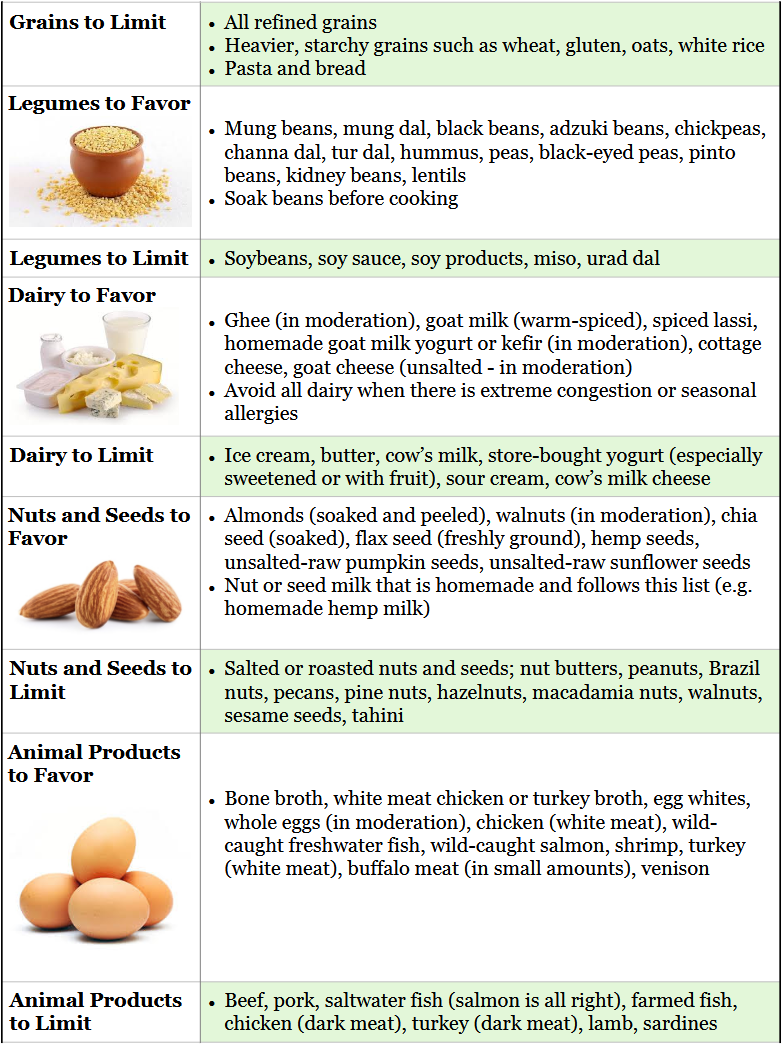
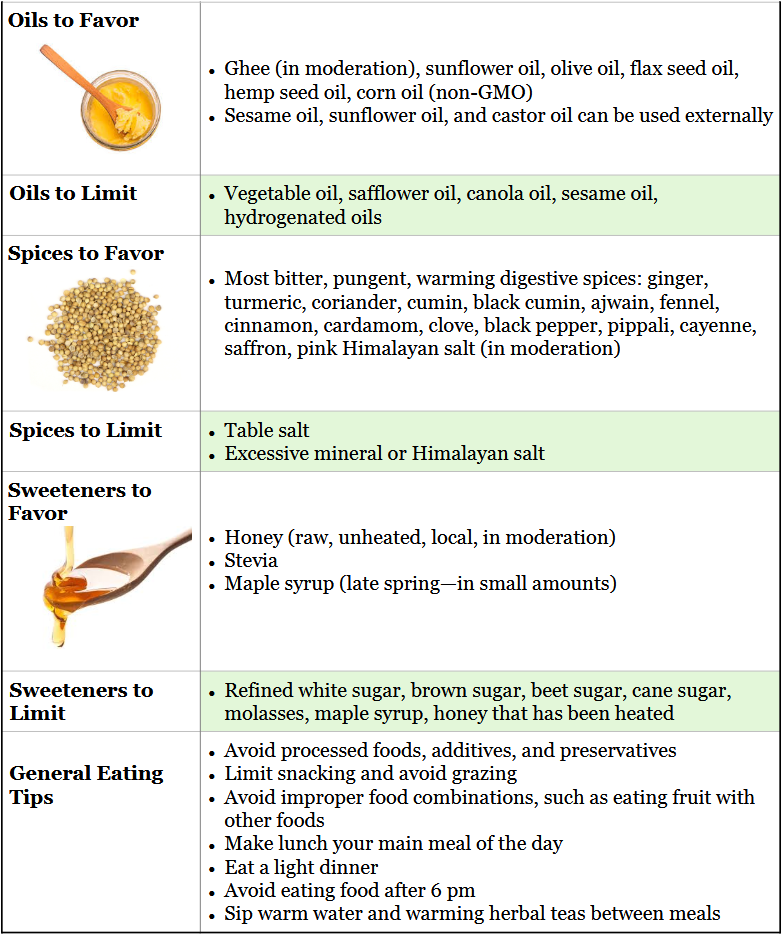
Click here for a printable PDF copy of this chart.
More Healthy Practices For Spring (your “extra credit”)
Eating for the season is a great start, but there are other ways to keep your body and mind light and bright for spring. Here are some simple tips to remember this time of year:
- Start the day with movement by performing 10 sun salutations before breakfast.
- Clear congestion, increase digestion, and awaken your mind by practicing Kapala Bhati pranayama each morning (perfect for after your sun salutations!)
- Take ½ to 1 teaspoon of Mahasudarshana Churna upon awakening to reduce Kapha, cleanse the system, and prevent seasonal allergies and sickness.
- Sip on a stimulating, cleansing herbal tea such as Tulsi Synergy Spice, Detox Tea, or AWAKEN Tea between meals to support healthy digestion, energy, and mental clarity.
- Always avoid cold or iced beverages, which can increase Kapha, hamper digestion, and clog the vital channels.
- If you are feeling damp and heavy, try sweating it out with a hot sauna or warm ginger bath 2 to 3 times a week.
- Perform self-oil massages (Abhyanga) with a warming, stimulating oil such as Kapha Massage Oil at least once each week.
- Get moving!! Make sure to get at least 30 minutes of intentional movement (aka exercise) daily.
- Spring is the perfect time for a cleanse; whether you prefer a short 3-day cleanse or a more in-depth at-home panchakarma—don’t miss this time to reset and renew!
Balancing Recipes For Spring
Spring Drinks, Smoothies, & Tonics
- Kapha-Balancing Tonic
- Immunity Broth Recipe
- Super Veggie Broth Recipe
- Detox Tonic Recipe
- Tulsi, Turmeric, & Ginger Tea
- Extra-Potent Ginger Tea Infusion
- The Essential Almond Milk
Spring Breakfasts
- Springtime Breakfast Scramble
- Breakfast Kitchari Recipe
- Tridoshic Cream of Quinoa Porridge
- Golden Energy Buckwheat Breakfast
- Simply Spiced Quinoa Porridge
- Sweet Potato Millet Porridge
Spring Lunches & Dinners
- Kapha-Reducing Kitchari
- Get Well Kitchari
- Liver Cleansing Kitchari
- Spicy Dal and Peppered Rice
- Tridoshic Red Lentil Dal
- Chickpea and Greens Brown Rice Bowl
- Tridoshic Quinoa and Veggie Stir-Fry
- Black Eyed Peas and Kale Rice Bowl
Spring Sides, Snacks, & Sweets
- Spicy Springtime Lemon Asparagus Subji
- Garlicky Golden Cauliflower Mashed Potatoes
- Dairy-Free Spinach Saag Recipe
- Spicy Sesame Quinoa
- Spicy Spinach, Kale, And Cauliflower Curry
- Best Basic Hummus
- Coconut Curry Hummus
- Balsamic and Lime Hummus
- Simply Steamed Veggie Recipe
- Ojas-Increasing Energy Balls
- Healthy Homemade Chocolate Hummus Recipe
- Badam Pak (Sweet Almond Bars)
- Saffron Spiced Laddu
- Homemade Kefir
Condiments & Spices
Keep Reading…
- Eat for the Winter Season: A Simple Guide on Ayurvedic Seasonal Eating (Part 1)
- Eat for the Summer Season: A Simple Guide on Ayurvedic Seasonal Eating (Part 2)
Discover our Kitchari Cleanse Kits!
Enhance your cleanse with our 7-Day Detox Kit!
Try our Ginger Bath Blend for your cleanse or daily self-care routine!
Ignite your digestive fire with our Kapha Churna spice blend!

